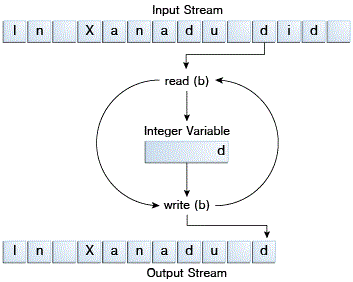I/O Streams
An I/O Stream represents an input source or an output destination. A stream can represent many different kinds of sources and destinations, including disk files, devices, other programs, and memory arrays.
Streams support many different kinds of data, including simple bytes, primitive data types, localized characters, and objects. Some streams simply pass on data; others manipulate and transform the data in useful ways.
No matter how they work internally, all streams present the same simple model to programs that use them: A stream is a sequence of data. A program uses an input stream to read data from a source, one item at a time:

Reading information into a program.A program uses an output stream to write data to a destination, one item at time:

Writing information from a program.In this section, we'll see streams that can handle all kinds of data, from primitive values to advanced objects.
The data source and data destination pictured above can be anything that holds, generates, or consumes data. Obviously this includes disk files, but a source or destination can also be another program, a peripheral device, a network socket, or an array.
In the next section, we'll use the most basic kind of streams, byte streams, to demonstrate the common operations of Stream I/O. For sample input, we'll use the example file xanadu.txt, which contains the following verse:
In Xanadu did Kubla Khan A stately pleasure-dome decree: Where Alph, the sacred river, ran Through caverns measureless to man Down to a sunless sea.
Byte Streams
Programs use byte streams to perform input and output of 8-bit bytes. All byte stream classes are descended from InputStream and OutputStream.
There are many byte stream classes. To demonstrate how byte streams work, we'll focus on the file I/O byte streams, FileInputStream and FileOutputStream. Other kinds of byte streams are used in much the same way; they differ mainly in the way they are constructed.
Using Byte Streams We'll explore FileInputStream and FileOutputStream by examining an example program named CopyBytes, which uses byte streams to copy xanadu.txt, one byte at a time.
import java.io.FileInputStream;
import java.io.FileOutputStream;
import java.io.IOException;
public class CopyBytes {
public static void main(String[] args) throws IOException {
FileInputStream in = null;
FileOutputStream out = null;
try {
in = new FileInputStream("xanadu.txt");
out = new FileOutputStream("outagain.txt");
int c;
while ((c = in.read()) != -1) {
out.write(c);
}
} finally {
if (in != null) {
in.close();
}
if (out != null) {
out.close();
}
}
}
}
CopyBytes spends most of its time in a simple loop that reads the input stream and writes the output stream, one byte at a time, as shown in the following figure.

Simple byte stream input and output.
Always Close Streams Closing a stream when it's no longer needed is very important — so important that CopyBytes uses a finally block to guarantee that both streams will be closed even if an error occurs. This practice helps avoid serious resource leaks.
One possible error is that CopyBytes was unable to open one or both files. When that happens, the stream variable corresponding to the file never changes from its initial null value. That's why CopyBytes makes sure that each stream variable contains an object reference before invoking close.
When Not to Use Byte Streams CopyBytes seems like a normal program, but it actually represents a kind of low-level I/O that you should avoid. Since xanadu.txt contains character data, the best approach is to use character streams, as discussed in the next section. There are also streams for more complicated data types. Byte streams should only be used for the most primitive I/O.
All other stream types are built on byte streams.
Character Streams
The Java platform stores character values using Unicode conventions. Character stream I/O automatically translates this internal format to and from the local character set. In Western locales, the local character set is usually an 8-bit superset of ASCII.
Using Character Streams All character stream classes are descended from Reader and Writer. As with byte streams, there are character stream classes that specialize in file I/O: FileReader and FileWriter. The CopyCharacters example illustrates these classes.
import java.io.FileReader;
import java.io.FileWriter;
import java.io.IOException;
public class CopyCharacters {
public static void main(String[] args) throws IOException {
FileReader inputStream = null;
FileWriter outputStream = null;
try {
inputStream = new FileReader("xanadu.txt");
outputStream = new FileWriter("characteroutput.txt");
int c;
while ((c = inputStream.read()) != -1) {
outputStream.write(c);
}
} finally {
if (inputStream != null) {
inputStream.close();
}
if (outputStream != null) {
outputStream.close();
}
}
}
}
CopyCharacters is very similar to CopyBytes. The most important difference is that CopyCharacters uses FileReader and FileWriter for input and output in place of FileInputStream and FileOutputStream.
Notice that both CopyBytes and CopyCharacters use an int variable to read to and write from. However, in CopyCharacters, the int variable holds a character value in its last 16 bits; in CopyBytes, the int variable holds a byte value in its last 8 bits.
import java.io.FileReader;
import java.io.FileWriter;
import java.io.BufferedReader;
import java.io.PrintWriter;
import java.io.IOException;
public class CopyLines {
public static void main(String[] args) throws IOException {
BufferedReader inputStream = null;
PrintWriter outputStream = null;
try {
inputStream = new BufferedReader(new FileReader("xanadu.txt"));
outputStream = new PrintWriter(new FileWriter("characteroutput.txt"));
String l;
while ((l = inputStream.readLine()) != null) {
outputStream.println(l);
}
} finally {
if (inputStream != null) {
inputStream.close();
}
if (outputStream != null) {
outputStream.close();
}
}
}
}
Invoking readLine returns a line of text with the line. CopyLines outputs each line using println, which appends the line terminator for the current operating system. This might not be the same line terminator that was used in the input file.